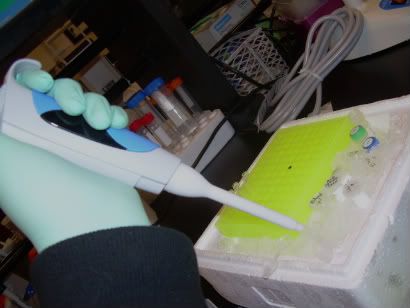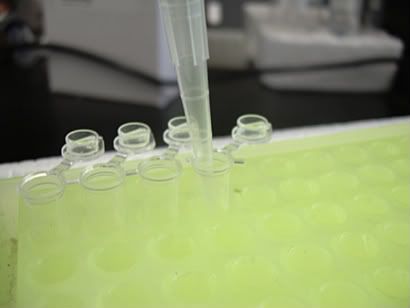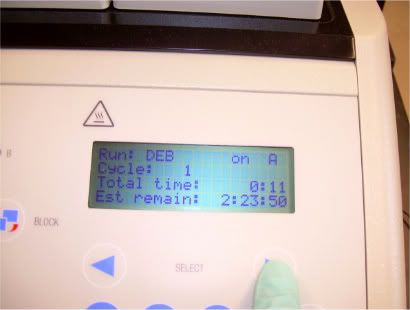In fact I'm pretty sure a well trained monkey could do most of what I do (note: do not tell my boss that a monkey could do it). So I'm gonna try to take the scary soundingness out of what is the backbone of just about any molecular lab: PCR.
PCR stands for Polymerase Chain Reaction, but to anyone who does it it's really code for "Piece of Crap not Reacting" PCR is one of those things that requires more prayer and finesse than just mixing stuff together (akin to baking as opposed to cooking). And anyone will break out into a cold sweat upon hearing the horrifying phrase "perfecting primers."
That's all nice I hear you saying but what does it do exactly? Why it is the magical procedure for amplifying DNA. It works quite simply where you rip the DNA strands apart, attach specific little sequences called primers, add a very expensive enzyme (damn patents) that will add all those G's, T's, A's, and C's that are DNA to make your specific segment.
If you've ever watched CSI you've seen the magical version where it works every time and is done in 10 minutes.
 This is my usual arsenal to begin PCR. The ice bucket is very important as part of the PCR prayer. Only by sacrificing frozen blocks of ice to the Science gods can one hope for an accurate amplification.
This is my usual arsenal to begin PCR. The ice bucket is very important as part of the PCR prayer. Only by sacrificing frozen blocks of ice to the Science gods can one hope for an accurate amplification.On the ice are all the tubes of special things I need: dNTPs (the C's G's and other letters), Primers, Reaction Buffer, DNA, Water (Don't worry you don't have to remember it, there won't be a test later). I got the two little pipetteman sitting in the bottom right corner all ready to dispense my liquids.
But probably the most important thing there is my calculator and the post-it notes. I have to make about 7 calculations, some in the range of 1-2 uL. How much is that? Well I'd say one small drop of water is about 10-20uL. 
 After calculating up all the special mixes of that fun important stuff I then pipette them into their special little baby tubes.
After calculating up all the special mixes of that fun important stuff I then pipette them into their special little baby tubes.Once they're all happy and ready to go (very important to spin the mix down or if you don't have the right centrifuge *cough*like us*cough* just bang the hell out of it on the counter) time to go into the thermocycler.  The thermocycler is a special piece of equipment that um cycles temperatures. Basically PCR works by altering the temperature at specific time increments and repeating the cycle. So while there is a typical program one can start with much like any recipe it can be messed with onto infinity to get a better product:
The thermocycler is a special piece of equipment that um cycles temperatures. Basically PCR works by altering the temperature at specific time increments and repeating the cycle. So while there is a typical program one can start with much like any recipe it can be messed with onto infinity to get a better product: As you can see, we now have 2 hours and 23 minutes to wait. This is about when you hope you have something important to do in lab that day (like say a little ring shoot) or you brought a really good book.
As you can see, we now have 2 hours and 23 minutes to wait. This is about when you hope you have something important to do in lab that day (like say a little ring shoot) or you brought a really good book.
Once the PCR is done, time to make a way to see it. So that means running it on an electrophoresis gel. This involves having to color the PCR product with a special running dye so we can watch it run on the gel and it doesn't just all run right off (I may or may not have some experience with that).
 Gel loading has a bit of a learning curve as those wells are a little tiny and near invisible til you get the first one in.
Gel loading has a bit of a learning curve as those wells are a little tiny and near invisible til you get the first one in. Now you just got to run the bad boy. DNA is negative so it runs towards the positive side of things when a current is introduced (or it's the otherway, I forget). For those of us that have no idea about electrical stuff (ME) black to back, red to front or your gel will run out of the top.
Now you just got to run the bad boy. DNA is negative so it runs towards the positive side of things when a current is introduced (or it's the otherway, I forget). For those of us that have no idea about electrical stuff (ME) black to back, red to front or your gel will run out of the top.If it had worked (which mine this time didn't, again) you'd get a pretty picture like this when looked at under UV (that's why all the lab nerds you see are so golden tan, wait).
 I've probably bored the hell out of most of you by now, but if you have any questions feel free to ask. I at least hope I've made science seem a bit less scary and more doable (though biochemistry will forever be pure evil).
I've probably bored the hell out of most of you by now, but if you have any questions feel free to ask. I at least hope I've made science seem a bit less scary and more doable (though biochemistry will forever be pure evil).

7 comments:
I don't think I'll be doing anything remotely similar, but that was cool. I adore CSI and wish I was as cool as you! You know how to work a lab. I am so jealous.
I am in awe of you!
WOW!!!!
"Piece of Crap not Reacting" -- awesome!
I don't think most non-science types realize just how much of lab work involves the scientist cursing and yelling "why won't you work, you stupid piece of garbage?!" while tinkering with the relevant piece of equipment/garbage. An old college friend who's doing a PhD in organic chemistry regularly uses her Facebook status to threaten bodily harm to the NMR.
Ooh NMR, that word is forbidden to all chemistry people.
My guy works with an HPLC so I get to hear about that some days.
Um, yeah.... do you hear that?? Oh, you don't?? Hmmm.... yes, I think you're right, the gears and wheels in my head HAVE come to a complete stop!! ;-)
That was a really really cool explanation of what you do - and very well written for total science dummies like me. Seriously, a monkey could so NOT do what you do, cuz I couldn't! But you did help to explain it a little better to me, at least I now have an idea about it.
I'm just left wondering - WHO CAME UP WITH THIS STUFF?? Who decided to rip apart DNA?? Who found out how to replicate it?? Who found out that by sequencing the temperature helps?? Who found out how long each cycle lasts?
I was more of an arts/history/english person in school. Math and science often made my head spin. ;-)
That's pretty intense.
Post a Comment